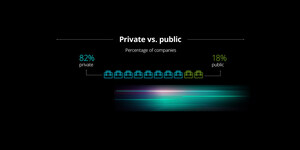Quick-fix Layoffs Strategy May Yield Better Return-on-Assets but Could Hinder Long-Term Economic Recovery: Deloitte 2011 Shift Index
Deloitte sees silver lining for companies that tap into intellectual capital of aging workforce
SAN JOSE, Calif., Nov. 14, 2011 /PRNewswire/ -- Companies relying on short-term measures to deal with current economic conditions, such as cost-cutting by way of layoffs for a potential increase in return-on-assets, risk long-term decline, according to Deloitte's 2011 Shift Index, released today by the Center for the Edge. In fact, the Index reveals that corporate economic performance in the United States has been declining over time as even the highest-performing companies struggle to maintain strong ROA rates while increasingly losing market leadership positions.
ROA is an indicator of management's efficiency at using assets to generate earnings. It is calculated by dividing a company's annual earnings by total assets. Despite labor productivity gains of nearly 250 percent, Deloitte's study finds that public companies in the United States have experienced a 75 percent drop in ROA over the last 40 years. The negative ROA trend is playing out across virtually all industries tracked in the Shift Index, suggesting a long term decline caused by deep structural changes. If companies remain too focused on the current economic conditions and the implementation of short-term solutions such as layoffs, they can be vulnerable to even greater competitive challenges in the long run.
"A profound structural issue weighing on our economy began well before the current economic downturn and likely will continue for the foreseeable future unless business leaders address the underlying challenges," said John Hagel, director, Deloitte Consulting LLP and co-chairman, Center for the Edge. "In this recessionary period, companies risk making decisions, such as layoffs, traditionally seen as prudent quick fixes that instead weaken their workforces and disrupt the flow of important knowledge, leaving them highly vulnerable amid intensifying global competition."
According to the Shift Index, a more effective approach for companies may lie in shifting their view of employees from cost items to be cut as pressure mounts to a powerful form of asset capable of delivering greater and greater value over time. Companies that invest in their workforces under tough economic conditions may be able to drive greater returns during periods of recovery.
The Impact of the Super-Empowered Individual
Deloitte's report indicates that super-empowered individuals are driving companies to be more transparent and find new approaches to cultivate brand preference and loyalty among consumers. Technology provides individuals with the power to drive short-term market fluctuations and is allowing them to leverage digital tools to organize in ways that previously were not possible. The Consumer Power survey (the basis of one of the Shift Index metrics) finds that 49 percent of consumers strongly agree they have more information about brands and products than ever before thanks to the Internet and social media tools. As a result, consumers wield greater power via social networks and sharing information in real-time. The survey also found that consumers trust businesses less often and seek out information via alternate sources rather than "buying in" to traditional advertising, manifesting in greater brand disloyalty.
Companies have the opportunity to use these same digital tools to draw new consumers to their offerings. According to Deloitte's analysis, social software also can be used within companies to cultivate a passionate workforce and tap into critical knowledge flows at all levels in order to reverse declining performance.
"Super-empowered individuals and passionate workers connect with like-minded people through social media to advance dialogue, learn and collaborate," said Hagel. "Organizations should tap into both when seeking champions for a particular cause or product."
Tapping the Passion of an Aging Workforce
According to the Bureau of Labor Statistics:
- The U.S. labor force is projected to reach 166.9 million by 2018;
- This represents an 8.2 percent increase from 2008, with an increasing proportion of older workers;
- Workers aged 55 years and older are anticipated to leap from 18.1 percent to 23.9 percent of the labor force during the same period.(1)
As the workforce ages companies should consider how to engage workers of all ages and enable them to tap into diverse knowledge flows to deepen their experience and allow for increased collaboration. The 2011 Shift Index suggests that fostering effective participation among workers of all ages can be a key driver of performance improvement as companies draw upon the deepest set of knowledge and skills.
"The ability to ignite and sustain the passion of older workers is becoming more and more important as the labor force ages. Organizations should explore options to retain retiring employees as advisors within the company," said Hagel. "Passionate older workers could be assigned roles where they can focus their energies on taking on performance challenges that have a measurable effect on a company. They often have well developed networks of relationships both within and across companies that can be very helpful in sustaining more robust flows of knowledge, accelerate learning and improve performance."
(1) United States Department of Labor: Bureau of Labor Statistics, Occupational Outlook Handbook, 2010-11 Edition
About the Shift Index
For a deeper look at the Shift Index methodology and findings, please go to www.deloitte.com/shiftindex.
As used in this document, "Deloitte" means Deloitte LLP and its subsidiaries. Please see www.deloitte.com/us/about for a detailed description of the legal structure of Deloitte LLP and its subsidiaries. Certain services may not be available to attest clients under the rules and regulations of public accounting.
Anisha Sharma Public Relations |
Sam Johnston |
|
Deloitte |
Hill & Knowlton |
|
+1 212 492 4427 |
+1 212 885 0499 |
|
SOURCE Deloitte
WANT YOUR COMPANY'S NEWS FEATURED ON PRNEWSWIRE.COM?
Newsrooms &
Influencers
Digital Media
Outlets
Journalists
Opted In






Share this article